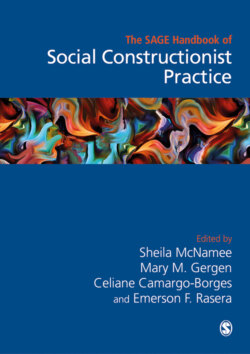Читать книгу The Sage Handbook of Social Constructionist Practice - Группа авторов - Страница 13
На сайте Литреса книга снята с продажи.
Scanning the Contours of Constructionist Theory
ОглавлениеTo appreciate the dynamic relationship between constructionist theory and innovations in practice, let us briefly return to its origins in the late 20th century. More extensive accounts can be found in a variety of sources (Arbib and Hesse, 1986; Burr, 2004; Gergen, 1994; 2015; Hacking, 1999; Hjelm, 2014; Lock and Strong, 2010; McNamee and Hosking, 2012; Potter, 1996; Weinberg, 2014). However, it is this very variety that calls attention to constructionism as an unfolding dialogue as opposed to a fixed theory with credited authorship. In general, however, one may trace the more immediate roots to the intellectual tsunami of the late 20th century, variously termed postmodern or post-foundational. Placed in question were the promises of unlimited progress through science. Such promises depended largely on the belief that because of their reliance on systematic and unbiased observation, the sciences could provide objective and value-free knowledge of the world. Armed with such knowledge, humankind could thus move beyond armchair speculation and ideological bias to predict and control the forces of nature. The harnessing of electrical energy, the curing of deadly diseases, and the developing of air flight were among the many illustrations of potential success. Despite these gains, the power of the natural science approach was not without limitations. Three lines of broadly shared critique played a major role in the decline of faith in the natural science approach, and the development of a social constructionist consciousness.
The first movement centers around value critique, or the unmasking of claims to value-neutral knowledge. As argued, all descriptions and explanations of the world – including those of the sciences – are saturated with values. Whether acknowledged or not, there are social and political ramifications of all truth posits. For example, research that differentiates between male and female genders discriminates against gender fluid people; psychological research lends itself to an ideology of individualism; economic research emphasizes the importance of wealth; and the natural sciences themselves – lodged in the assumption of a material world – denigrate those whose lives are anchored by religious and spiritual beliefs. Within the scholarly world, such commentaries have played a major role, from early Marxist and feminist movements, to the work of Foucault (1979; 1980), and onward to include the critical voices of virtually every marginalized minority.
The second line of critique centers around language as representation. The positivist vision of science was largely committed to the view that language can function more or less like a picture or mirror to nature. With developments in semiotic theory in general and literary deconstruction in particular (Derrida, 1976), attention was variously drawn to the ways in which conventions of language precede all claims to knowledge. Whatever nature may be, its representation will inevitably be dominated by traditions of representation. For example, to describe the world in English language will demand the use of nouns. Regardless of the nature of the world, in relying on nouns the description will automatically segment the world into separate units (persons, places, or things). Or, to make a compelling description of events over time (for example, Darwinian theory, or an account of child development) will take the form of a narrative. Such proposals are also congenial with Wittgenstein's (1953) view of language as a social practice, with differing linguistic traditions reflecting different ways of life. Words are not maps or pictures of the world as it is, but ways of representing the world within particular communities. What we might commonly index as ‘a person’, might variously be described as a mammal, a living system, a father, a schizophrenic, or a sinner, depending on the language community from which one is drawing.
The third significant line of critique counters the philosophic claims to logical foundations of science with a social account of knowledge making. Of major importance here was the 1962 publication of Thomas Kuhn's The structure of scientific revolutions. Kuhn portrayed normal science as guided by paradigms – an array of assumptions and practices – shared by particular communities. What we view as progress in science, he proposed, is not the result of increasing accuracy in understanding of the world, but the product of shifting paradigms. In effect, we make progress not by ‘seeing better’ so much as ‘seeing differently’. This critique of foundational science was further buttressed by a welter of inquiries demonstrating the way in which what we take to be ‘facts’ are established through an elaborate and unsystematic process of social negotiation (see for example, Feyerabend, 1975; Latour and Woolgar, 1979). Historians added to the argument by illuminating how the very concepts of objectivity and truth have emerged and changed across cultures and times (Daston and Galison, 2010; Shapin, 1995).
Together these three lines of reasoning converge toward a view of knowledge as socially constructed. Knowledge making is understood then, as a social process invariably reflecting the values, assumptions, and ways of life of the time and culture. Or more generally, what we take to be true as opposed to false, objective as opposed to subjective, scientific as opposed to mythological, rational as opposed to irrational, moral as opposed to immoral is brought into being by communal activity. This does not at all eliminate the importance of truth claims, but invites cognizance of the time, place, and communities for whom they have value (or not). When flying across the country, it is wise to trust the knowledge of the community of engineers who designed the plane, and to vilify anyone who intentionally falsifies their account of the aircraft's safely. Constructionist ideas invite, then, our replacing of the traditional image of a universal, value-free knowledge, with an orientation of reflective pragmatism. What we should ask of various knowledge-making communities, is what they offer to the world and for whom these offerings are valuable or not. These themes will reverberate throughout this chapter and this Handbook.
